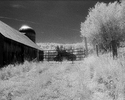Kino
Subscriber
While out doing some Fall yard work I noticed back in a fence row I typically don't pay much attention to, an abundance of Poke Berries fully ripened.

Remembering how I got into terrible trouble with my mother when, as a mere tyke, I picked a bunch and then wiped my hands on my shirt and pants. The deep magenta stain ruined my clothes and stained my hands for several days before it faded away. (BTW: No, I did not eat them. She caught me just as I was about to try one!)
That got me to thinking that it should be a good dye to experiment with overall or selective tinting Cyanotype prints.
I therefore gathered about 225 grams of ripe berries, crushed them and covered them with about 175ml of 91% Iso Alcohol. I plan to leave them overnight and then strain the liquid through doubled-up coffee filters into a small brown bottle, top it off with more Alcohol and maybe put a drop of Formaldehyde in for preservative.

But now, I am wondering if, rather than topping it off with Alcohol, I should top it off with Acetic Acid, as Cyanotypes (I read) tend to hold their blue color better when biased to acid?
Anyone have any suggestions or experience with natural dyes and Cyanotype tinting?
Remembering how I got into terrible trouble with my mother when, as a mere tyke, I picked a bunch and then wiped my hands on my shirt and pants. The deep magenta stain ruined my clothes and stained my hands for several days before it faded away. (BTW: No, I did not eat them. She caught me just as I was about to try one!)
That got me to thinking that it should be a good dye to experiment with overall or selective tinting Cyanotype prints.
I therefore gathered about 225 grams of ripe berries, crushed them and covered them with about 175ml of 91% Iso Alcohol. I plan to leave them overnight and then strain the liquid through doubled-up coffee filters into a small brown bottle, top it off with more Alcohol and maybe put a drop of Formaldehyde in for preservative.
But now, I am wondering if, rather than topping it off with Alcohol, I should top it off with Acetic Acid, as Cyanotypes (I read) tend to hold their blue color better when biased to acid?
Anyone have any suggestions or experience with natural dyes and Cyanotype tinting?





 )
)


